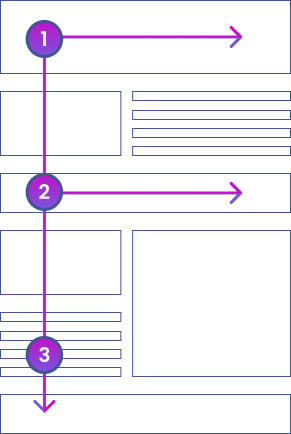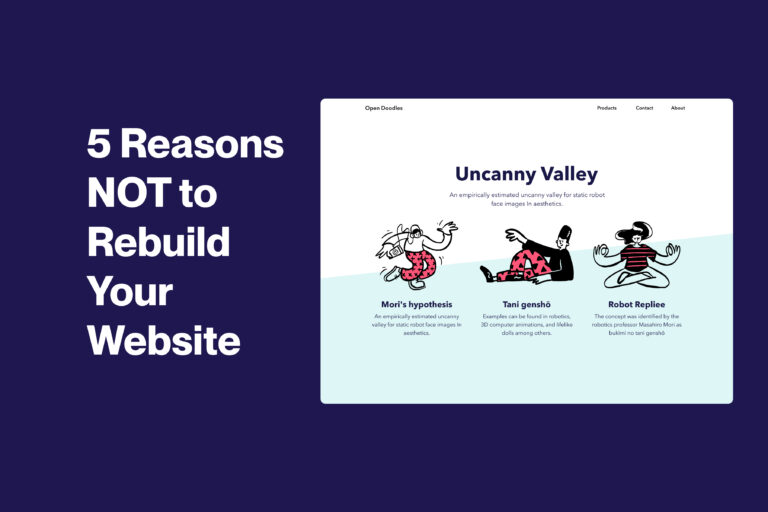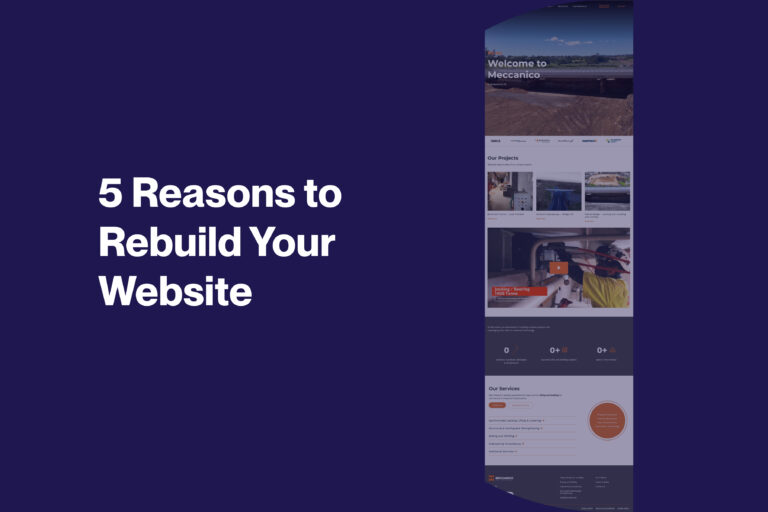- Make your website easy to use, with clear menus, simple explanations, and a mobile-friendly design.
- Include high-quality pictures and videos along with informative writing that's easy to follow.
- Use website tracking tools to see how your site is doing.
- Develop a clear message that quickly explains what you offer and why it's great.
Online competition is fiercer than ever. With over 1.8 billion websites on the internet, it pays to stand out, to know your market and to use every trick in the book to win over new customers.
Getting traffic to your page is only half the battle. Connecting with visitors and capturing their attention needs to be seamless so that your website closes more business.
Here are 10 of the things we do to boost website performance and keep your business on top.
1. Website Functionality, Usability and Website Design
Why?
Customers expect an easy to use and highly functional website
Key Points
- Difficult navigation or confusing website page structure will increase bounce rate
- Have strong ‘Call To Action’ buttons that let your website visitor know what to do next
- Create an F shaped pattern for your website users to easily digest information
Difficult website navigation and poor design is a death sentence for a website. Website navigation is second nature to online shoppers these days, so it pays to play to your customers’ expectations and for your website to be intuitive.
A sale is all the more likely if customers don’t need to wonder “what’s the next step?”, “Do I trust this business?”or to be left wanting more information from the website.
Your website traffic will be more inclined to purchase a service/product when the navigation and use of the site is easy and simple.
Call to action buttons and correct structuring of information will guide customers through the website in a methodical way that always leads to more conversions and sales.
Users navigate a website by using the F-Shaped reading pattern which is the most common way in which website visitors will digest content and information. Shown in the diagram below.
Users will digest information more easily when text has its own separated space and is noticeably different to the next section of information. When text and imagery is easily identifiable, users will feel at home and spend longer on the website.
F– Shaped Pattern Reading

Studies have shown that what individuals see is the top and left areas of the screen. This layout depicts our natural pattern of reading in the West (left to right and top to bottom)
A website design that incorporates this will work effectively with a readers natural pattern of view.
2. Written Content
Why?
Genuinely unique website content builds trust and shows authority.
Key Points
- Have a hierarchy of information on your website
- Create punchy key statements / headings that get the point across quickly
- Relevant blogs will boost your authority and engagement
- Well written content will increase user time on your website
When you backup beautiful design and imagery with strategically written content, you get a step closer to a highly performing website.
Written content is the best way to communicate your core values, educate your customers and build trust. When your content says all the right things, it will align with your target audience and can more easily build enough trust to gain a sale or conversion.
Start displaying your written website content in a hierarchy from most to least important. Create punchy, aspirational key statements as headings to support your written content.
As the attention span of individuals when using websites is a mere 8 seconds, and less than 25% of text will be read.
This makes your key statements all the more important as they may be the only ones that users will absorb. If you can’t share the relevant information in the fastest possible way through catchy headings then your website will be fighting a losing battle against these short attention spans.
When designing a website, having relevant written content will be beneficial to many users that may need more information on the service or product that is being provided. This will give the potential buyer more knowledge on these elements and how it can benefit them.
When website content is well-written, your audience is more inclined to stay engaged.
More time on page will also boost awareness and conversions as it would be optimised for a higher rank in web results. There are also many different tips and tricks that you can use to engage your audience and keep them on your site for longer. (Link to 10 marketing tips – 3rd point: grab your audience’s attention)
Other written content that can be used on the site are blogs which discuss various topics which may relate to the business or other aspects of the business world. This type of content would be great for different audiences that want to know more and are researching about a specific topic.
Special mention needs to be made for testimonials.
Social proof ranks highly on the list for buyers making a decision whether or not to use your products or services.
Customers look for others’ opinions to gain more information and to validate their purchasing decision.
3. Website Visuals, Imagery and Video
Why?
More than 80% of our brain power is allocated to processing visual information
Key Points
- Use a range of visuals to keep your website interesting
- Professional photography, videography will always pay off
- Good visuals will make your website visitors more forgiving for any less interesting parts of your website
It’s mind blowing how many business owners pay for ads, but have no idea what the cost of acquiring each lead or or sale is.
Even when paying for ads management, proper conversion tracking often isn’t set up and data can be easily misleading or too complex to understand.
Once analytics is set up properly, it will provide the right sort of information such as the costs of acquiring that traffic / where traffic comes from, how traffic interacts with the site.
Once you know this you can start to focus on enhancing areas that work, mitigate against wasted spending and bring the cost of acquiring new leads down.
Analytics provides reports that can display various types of elements such as leads, conversions, visits, bounce rate and time on your website. Overall, tracking enables how effective your marketing and advertising campaigns are. There are also tips that can be used to help boost traffic to your website and its ranking which includes reports, optimising the website layout, understanding what search keywords are sending traffic, analyse top search pages and internal linking. (Link to 10 Google Analytics Tips)
These analytics link to search engine optimisation also known as SEO. This is the process of improving traffic to a website or web page from a search engine and would target unpaid traffic. SEO is also essential as it provides 50% of all site traffic, how well the website is performing and what the business can do to increase their click through rate.
4. Mobile optimisation and responsive design.
Why?
Mobile browsing makes up over 60% of all traffic and is steadily rising
Key Points
- Make your site easier to use for people on the go
- 60% of searches are made on mobile
- Over 70% of food and beverage searches are made on mobile
- Mobile friendly sites increase your google ranking
Having your website optimised for mobile or responsively designed will ensure that all users on any device have a smooth interaction with
your site.
If you are at the design stage of your website you should find out how the information on your site will format itself on both mobile, Ipad
and desktop.
A good website design and development agency should be able to show to you how your website will look on mobile first, before development, so there’s no nasty surprises when you log on for the first time.
Mobile friendly optimisation includes the different display layout of your content so that it is easily usable. Bigger, clickable calls to actions and links that are thumb friendly make it easier than going for small buttons that haven’t been optimised.
Mobile friendly design ensures that all phone numbers, email addresses and physical addresses launch their respective application, be it phone, mail, or map application.
With over 6 billion mobile users worldwide, why wouldn’t you optimise for mobile? It will ensure that your website and its elements are readily accessible for users/buyers that are interested in purchasing your product/service.
Mobile friendly websites will build credibility with your customers as they will have a positive experience where they view your business as a reliable source for information, with products or services that are easy to use.
Individuals are also more inclined to use their smartphones to shop online as it is more convenient and efficient if they are on the go and can’t be near a computer to do so. It also allows for a larger brand awareness as anyone worldwide can discover your site on the go which is where advertising and marketing would be essential.
Optimising for search engines can also relate to being mobile friendly as Google has prioritised mobile friendly sites in comparison to those that are not and allows for these mobile friendly websites to rank better. It is also extremely easy to use your Google on your smartphone to search for various services and products. Keywords can also be extremely useful as it optimises your mobile site to rank better.
5. Proper Website Analytics and Tracking Setup
Why?
Mobile browsing makes up over 60% of all traffic and is steadily rising
Key Points
- Find a switched on ads manager with simple reporting
- Analytics can help to problem solve website performance issues
- See exactly what goes in to getting a lead or sale
It’s mind blowing how many business owners pay for ads, but have no idea what the cost of acquiring each lead or or sale is.
Even when paying for ads management, proper conversion tracking often isn’t set up and data can be easily misleading or too complex to understand.Even when paying for ads management, proper conversion tracking often isn’t set up and data can be easily misleading or too complex to understand.
Once analytics is set up properly, it will provide the right sort of information such as the costs of acquiring that traffic / where traffic comes from, how traffic interacts with the site.
Once you know this you can start to focus on enhancing areas that work, mitigate against wasted spending and bring the cost of acquiring new leads down.
Analytics provides reports that can display various types of elements such as leads, conversions, visits, bounce rate and time on your website. Overall, tracking enables how effective your marketing and advertising campaigns are. There are also tips that can be used to help boost traffic to your website and its ranking which includes reports, optimising the website layout, understanding what search keywords are sending traffic, analyse top search pages and internal linking. (Link to 10 Google Analytics Tips)
These analytics link to search engine optimisation also known as SEO. This is the process of improving traffic to a website or web page from a search engine and would target unpaid traffic. SEO is also essential as it provides 50% of all site traffic, how well the website is performing and what the business can do to increase their click through rate.
6. Website Interactivity / Gamification
Why?
Create more engagement, word of mouth and be hard to forget.
Key Points
- Gamification can create more of a buzz around your website and your business
- Can be used in any industry on any website
- Will increase time on page and rankings
Gamification is great! On so many levels. It provides an escape, inspires competition, it’s surprising and amusing, can give incentives and advertises in a far more captivating way.
Check out a few websites that do a great job of it.
https://adventuremachine.4thfloorcreative.co.uk/adventuremachine/
There are simple ways to do it like spinning a wheel for a discount or you can get more complex by giving users tasks to complete for rewards / badges or creating a digital landscape for your website users to navigate through. Anything is possible.
Creating an interactive website means that visitors will be more engaged to stay on your site for longer and also creates an experience that will be hard to forget.
There are many ways that you can create an interactive website which could be through social media applications, interactive tools & elements, forms & feedback, gamification or widgets.
Although there are many other features that can work, it is important to understand what type of interactive tool is working best on your website and what needs to be changed/improved on to gain successful leads/conversions.
Testing different features individually or in combination can be helpful in deciding which aspect works best for your business and the results it brings.
It can also be helpful to see what other businesses are doing with their websites and take notes on how you can improve yours.
7. Website Tracking, A/B testing & Conversion Rate Optimisation
Why?
Eliminate sales funnel blockages and shine light on hidden opportunities.
Key Points
- By testing and changing a few small things, big things can happen
- Explore different ideas and incorporate winning tests back into design
- A/B Testing will help you prioritise what to do in the future on your website
A/B testing is where you compare two different versions of an aspect on a webpage or email to analyse the difference in performance. You’ll gain clear data and be able to either run further testing to explore other opportunities that present themselves from the test or just incorporate the favourable testing into your main website.
Testing can help to analyse your conversion funnel and marketing campaign based on the customers behaviour.
When A/B testing is done, it allows for you to understand what was effective on each site and what wasn’t. This means that you can combine the aspects that had worked well or chose the site alone that worked the most efficiently in creating leads.
There are 10 elements that should be included in website testing as these aspects contribute in creating conversions. These are headlines, CTAs, visual content, email subject lines, content depth, product descriptions, social proof – opinions, testimonials, email marketing, media mentions and landing pages.
You can explore different page layouts, colours and photos and their impact on conversions too.
It is always important to make note of what you want to test, what you want from the data and how you can make various aspects more efficient.
8. Website and Webpage Loading Speed
Why?
Give your customers what they want. Fast.
Key Points
- Slow load times = less traffic
- A fast site will increase customer satisfaction
On average, if your website takes longer than 3 seconds, 40% of visitors will leave which translates to a massive loss in conversion rates/leads/sales.
Loading speed is vital in keeping your visitors on your website and converting them.
Google uses speed / load times as a ranking signal which will determine how highly ranked your website is on Google’s search engine. The speed is also essential in creating a lasting impression on the user if it is their first time on the website.
Users will judge your website in various ways such as if the website was easy to navigate, the website loading speed was slow and there were no interactive elements mentioned above.
Other factors that should be considered when creating a fast loading website are that users are always on the go which means that the website should be able to load fast when visiting sites on their smartphones or other devices.
Another factor is that the speed can impact digital marketing if the site was made for ecommerce as the business would want to create a positive, easy experience for the buyer. Lastly, another factor may be the results that the website would be getting from conversions of the website is slow.
9. Lead magnets
Why?
Let your customers dip a toe in the water
Key Points
- Gain valuable information
- Better understand your clients needs
- Create more touch points and more commitment
- Attract more ideal customers
- Transition website customers from cold to hot
A lead magnet or widget is a free item or value add also known as a “bribe to subscribe” that is provided to website visitors to gather data such as contact details, preferences or opinions. Lead magnets come in the form of free trials, samples, instant pricing forms, quizzes, case studies, how-to-guides etc.
No matter what business or industry you are in there is a website lead magnet that will be a fit for you to gain more qualified website leads and ultimately more sales.
Lead magnets also help a business to gain exposure, awareness, trust and likability. Potential customers are then able to decide how they are feeling about your business and if they want to do business with you. Most buyers like the idea of getting to try you out at no risk and dip a toe in the water. The customer can then get to know you a little more, see what you are about and proceed with you at their own pace
10. Use a Messaging Framework
Why?
Let your customers dip a toe in the water
Key Points
- Get your information across in the fastest possible way
- Intelligently explain who you are and why your solution is better
Last but not least, Messaging Framework is powerful content structuring that Pinpoint implements on almost all of our website builds.
It is based on identifying a few things that help to tell a good story on a website. Such as:
The Aspirational Change – Who will your customer become after using your product or service?
The Need – What does your customer need
The Issue – What problem are you solving for your customer
The Solution – How do you show authority and empathy in solving the issue
The Plan – What simple plan can you give to your customer
The Call to Action – Provide a reason your customer should take action
The Successful Ending – What positive benefits will your customers get and what negatives will your customer have avoided by using your product or service
The above can be mapped out on a website through a combination of written content or any other visuals listed in the visuals section.
The whole point of this framework is to quickly convey each piece of information that a website visitor may need in order to understand that your solution is the one for them.
No matter how hot or cold they are or what stage of the journey they are at. They may only just be problem aware, or they may be ready to buy. But when the information is laid out in a messaging framework, there will be the right bits of content for every website visitor.
If you made it this far, we hope you enjoyed it and that there were some gold nuggets here for you and your business.
Share your comments or feedback and let the Pinpoint team know if you have queries to do with your digital marketing.




